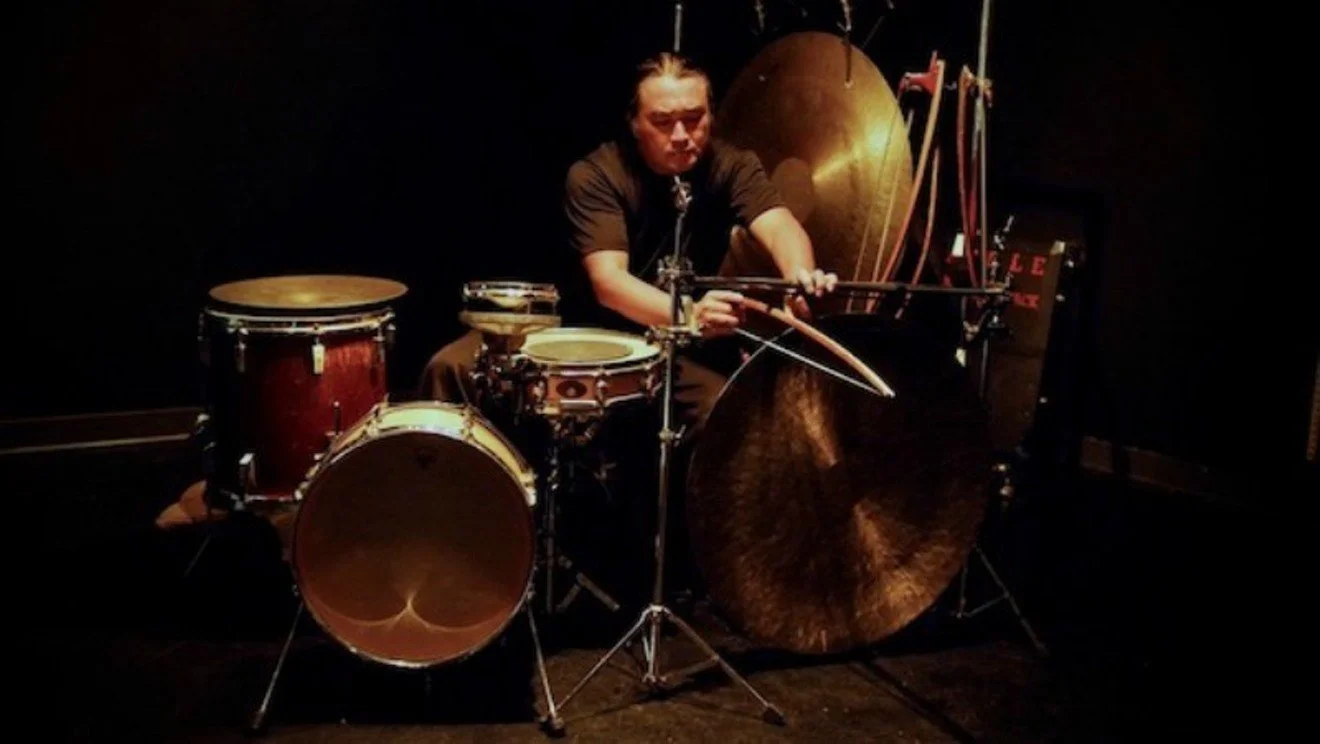With a hand-carved bow and a gong, master percussionist Tatsuya Nakatani creates otherworldly sounds
Powell Street Festival Society brings the New Mexico-based, Osaka-born musician to Vancouver for two concerts
Tatsuya Nakatani discovered the drums in high school in Japan.
Powell Street Festival Society presents Tatsuya Nakatani in a solo show on November 10 at 7 pm at the Massy Arts Society and with bassist Mark Haney on November 13 at 2:30 pm at the Nikkei National Museum and Cultural Centre in partnership with Massy Arts Society and DKAM. Tickets are by donation.
A LARGE GONG fronts Tatsuya Nakatani’s drum kit, and the way he plays it may come as a surprise to anyone who’s new to the avant-garde percussionist’s performances. An artist of sound, Nakatani approaches the copper disk with a self-made hand-carved bow, sliding it back and forth along the rim to create mystifying, mesmerizing, otherworldly sounds. The Osaka-born musician also places cymbals and small Buddhist singing bowls right on top of his drums, the pieces dancing atop the surface as he strikes it. He scrapes cymbals across the drums’ skin or brings his mouth to the metal instruments to create new noise. It’s not so much a concert as an intensely captivating one-man aural experience.
“In general, with a percussive instrument, when you hit it with a stick or a mallet, it’s an attack, and an attack decays to become silent,” Nakatani tells Stir on the line from his home in Truth or Consequences, New Mexico. “In my percussive approach, I use the bow to make a longer, sustained sound. With a bow, there is no attack; you can keep the sound going for 40 minutes or one hour—you can keep it going for a long, long, long time, and that sustained sound is very powerful. I will also have more than one gong, and when you have five or 17 or 19 or however many, it’s kind of like a metallic symphony.
“I missed live music so much during the pandemic,” he adds. “For my work, it doesn’t do well with an online performance. If you are there, you can discover many things; it is a vibrational project. You will feel it. That is an important fact of live music; it is more than just music but more human exchange. I produce something, they observe it, and they probably send it back to me. It’s very powerful for live performance.”
Local audiences can feel the vibration when Powell Street Festival Society brings Nakatani to Vancouver for two performances: a solo concert November 10 at Massy Arts Society; and a show with composer and double bassist Mark Haney (artistic director of Little Chamber Music and composer-in-residence at Mountain View Cemetery) on November 13 at Burnaby’s Nikkei National Museum and Cultural Centre.
The intimate concerts will give audiences a chance to see up close Nakatani’s custom bow. Nakatani fell in love with percussion in high school, and early in his career, he played with commercially available bows, such as those for contrabass or cello. However, they lacked the powerful sounds he craved. So about a decade ago, he began making his own, and he now has a long waiting list of musicians from around the world who want to order one and be able to create their own unique sounds.
Here’s how Nakatani explains the bow’s name on his site: “Kobo is Art made by an Artist for another Artist to make their Art, it is not a commercial product. In a way, Kobo is a relationship.
“You must step out of the idea of the traditional bow to use Kobo,” he says. “The sound, length, weight, touch, feel, and type of energy are all different. Kobo stands alone as an experimental tool that can take you away from hundreds of years of traditional sound.”
Nakatani makes many different styles, from “all purpose” percussion short length bows to guitar bows, using a durable synthetic hair and a range of hard woods, including Brazilian cherry, oak, walnut, hickory, European beech, and Mexican rosewood. It takes him roughly 20 hours to carve each one by hand. (His mom has made covers for them on her sewing machine at home in Osaka, while his return policy is this: “A Kobo Bow is a work of art, no returns and no complaining.”)
He sources his singing bowls from Buddhist shops in Japan. “There are so many kinds and so many beautiful singing bowls,” he says. “They are quite expensive. The shape of the bottom is round, so it doesn’t sit somewhere comfortable; when I hit the drum it tries to move around.”
Although he has a home in New Mexico, Nakatani typically spends the majority of time travelling, describing himself as a “nowhere person”. Nakatani has released more than 80 recordings, teaches master classes around the world, and has a large ensemble project called the Nakatani Gong Orchestra.
A recurring theme in his music is the Japanese concept of “ma”, meaning “the space between”. It relates to all aspects of Japanese art and culture, he says; in music, it is the idea that silence creates sound.
“Ma is space or air something to indicate what is between point A and point B,” Nakatani says. “Spacing is very important. For my use, I include it in my percussive notes. Instead of using the rest signature, I put ma behind the sound. It’s a very powerful segment.”
“I’m technically improvising all the time, meaning spontaneously composing,” he adds. “You have to keep ahead of the time and understand what’s in the past. I am pretty busy during a performance. I’m always thinking about the formation of the next chapter.”
For more information, see Powell Street Festival Society.














